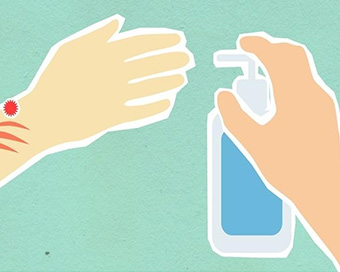Gallery
 PM Modi visit USA
PM Modi visit USA Only the mirror in my washroom and phone gallery see the crazy me : Sara Khan
Only the mirror in my washroom and phone gallery see the crazy me : Sara Khan Karnataka rain fury: Photos of flooded streets, uprooted trees
Karnataka rain fury: Photos of flooded streets, uprooted trees Cannes 2022: Deepika Padukone stuns at the French Riviera in Sabyasachi outfit
Cannes 2022: Deepika Padukone stuns at the French Riviera in Sabyasachi outfit Ranbir Kapoor And Alia Bhatt's Wedding Pics - Sealed With A Kiss
Ranbir Kapoor And Alia Bhatt's Wedding Pics - Sealed With A Kiss Oscars 2022: Every Academy Award Winner
Oscars 2022: Every Academy Award Winner Shane Warne (1969-2022): Australian cricket legend's life in pictures
Shane Warne (1969-2022): Australian cricket legend's life in pictures Photos: What Russia's invasion of Ukraine looks like on the ground
Photos: What Russia's invasion of Ukraine looks like on the ground Lata Mangeshkar (1929-2022): A pictorial tribute to the 'Nightingale of India'
Lata Mangeshkar (1929-2022): A pictorial tribute to the 'Nightingale of India' PM Modi unveils 216-feet tall Statue of Equality in Hyderabad (PHOTOS)
PM Modi unveils 216-feet tall Statue of Equality in Hyderabad (PHOTOS)India Open Competition in Shotgun, organised by the National Rifle Association of India (N
- Hockey India names Amir Ali-led 20-man team for Junior Asia Cup
- Harmanpreet Singh named FIH Player of the Year, PR Sreejesh gets best goalkeeper award
- World Boxing medallist Gaurav Bidhuri to flag off 'Delhi Against Drugs' movement on Nov 17
- U23 World Wrestling Championship: Chirag Chikkara wins gold as India end campaign with nine medals
- FIFA president Infantino confirms at least 9 African teams for the 2026 World Cup
The truth about products that claim to kill 99.9% germs Last Updated : 24 Aug 2021 01:53:53 PM IST 
From SARS to H1N1 and now Covid-19, the last decade has seen many viruses and flues due to 'germs'. This has also given rise to dozens of new products which brag about their microbe-killing properties.
Preventive hygiene products including sanitisers and handwashes, home care products like floor and toilet cleaners, come with a disclaimer that they kill 99.9 per cent, or 99.99 per cent, of common bacteria and fungi. We have seen it in ads, read them on labels ad nauseum.But have you stopped to consider what this actually implies?A claim such as 99.99 per cent germ kill may not be a plausible promise that many products can actually keep when it comes to their performance across various types of germs like bacteria, viruses, fungi, and spores. While products can be 99.99 per cent effective on one type of germ may not be effective on others that are tough to disinfect.Some of the most popular products carrying this claim are effective on only a small spectrum of germs and pathogens. The proof comes in the form of a fine print somewhere on the container that lists the germs a product actually kills. And this list may or may not include some or all of the viruses. This means the spectrum of 100 per cent is a limited one, to begin with.Not all disinfectants and medical fluids are created equal. Contrary to popular belief, disinfectant solutions may differ from each other in many different ways. They may also have different efficacy claims and dilution ratios. The most common disinfectant solutions used for facility maintenance or deep germ kill action are composed of active ingredients like sodium hypochlorite (bleach), quaternary ammonium (quat), hydrogen peroxide, silver ions, alcohol or acids, iodine etc. Each of these has its own germ-ridding characteristics, and when mixed with other compounds to be made into a solution, they may be effective on different strains of pathogens.So, what should you look out for?* Look for third-party certifications -- Products certified by an independent testing facility, preferably ISO-affiliated, are unlikely to be able to claim something they do not deliver on. These details can be found on the labels of the products you pick. Go beyond ads and top-line claims -- read the small print and engage before you purchase.* Be conscious of the usage scenario -- When picking a product, look for active ingredients responsible for disinfection. Brands like Domex Surface and Floor Disinfectant have Sodium Hypochlorite as an active ingredient. It is one of the most powerful disinfectants available and works on a broad spectrum of germs like bacteria (both gram-positive and gram-negative), viruses (both enveloped viruses and more difficult to disinfect non-enveloped viruses), fungus and spores. The various scientific literature confirms that Sodium hypochlorite is fast-acting and unaffected by hard water.* Be wary of products that try to do more than one job -- 8/10 times products that try to sell themselves as a freshening and disinfecting agent combined into one may be diluted, thereby less effective versions of products that focus on one core premise.* Read up on the technology/science the product is using to make it happen.* Product description sections on e-Commerce platforms, labels or the product website are good places to go searching for this information.The use of disinfecting agents is important, especially at a time when everyday hygiene is of absolute significance. However, it is imperative that we take a moment to assess the product specifics, and its certifications to truly judge efficacy. As consumers, we should be cognizant of what we are paying for at the end of the day.IANS New Delhi For Latest Updates Please-
Join us on
Follow us on








172.31.16.186







